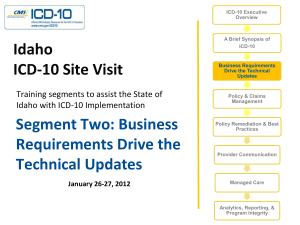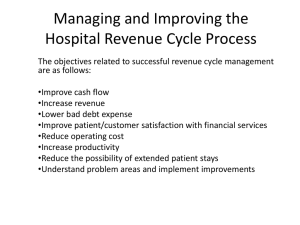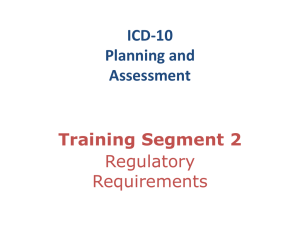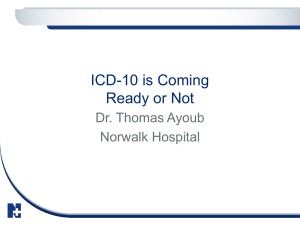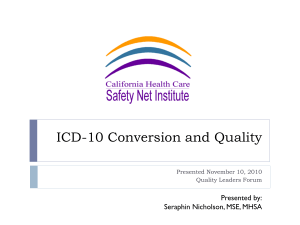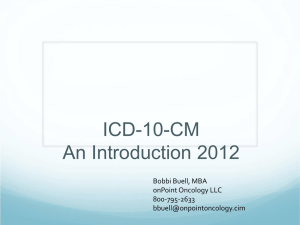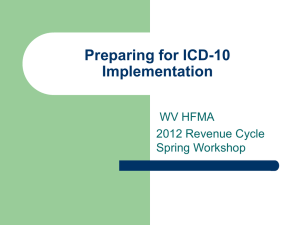ICD-10 Overview
advertisement
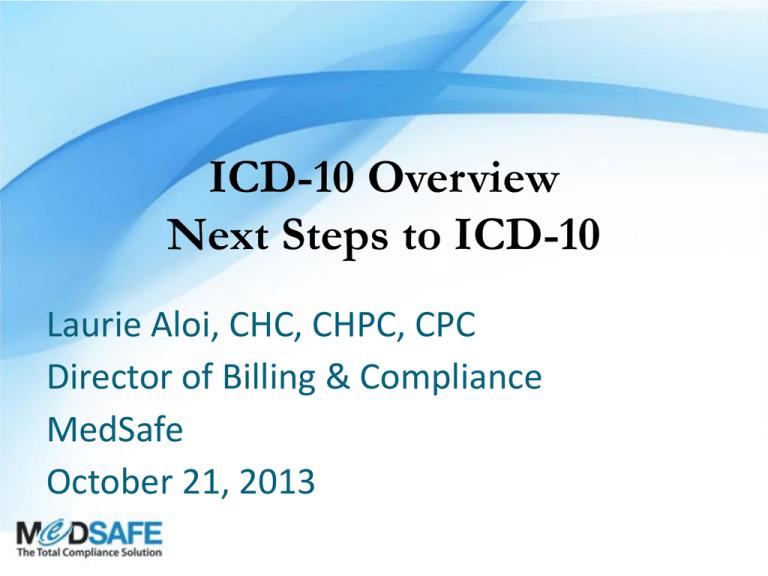
ICD-10 Overview Next Steps to ICD-10 Laurie Aloi, CHC, CHPC, CPC Director of Billing & Compliance MedSafe October 21, 2013 Agenda Understanding what’s coming Timeline and history Delay in Implementation What is ICD-10? Side by Side examples Review of Coding Guidelines Planning for a Successful Transition When? The Department of Health and Human Services (HHS) originally announced the plan for ICD-10-CM implementation. In August 2009, CMS announced the implementation date would be October 1, 2011 The date was pushed back in January 2009 after MGMA and AAPC appealed to CMS that the training and software transition would be a burden to the medical profession Practices have had 4 years to prepare and should be learning about What ICD-10 is What will need to be done to prepare And Now? On February 16, 2012 HHS Secretary Kathleen Sebelius has announced that the October 1, 2013 date for implementation of ICD-10 has been pushed back indefinitely “ICD-10 codes are important to many positive improvements in our health care system. We have heard from many in the provider community who have concerns about the administrative burdens they face in the years ahead. We are committing to work through the rulemaking process, with the provider community, to reexamine the pace at which HHS and the nation implement these important improvements to our health care system.” 5 New Implementation Date On April 9, 2012, CMS announced that the new implementation date will be October 1, 2014 The extra year will give medical practices more time to shift from the demands of Meaningful Use and Quality, to the issues of training and implementing ICD-10 Why change from ICD-9? ICD-9-CM has several problems. After 30 years, it is no longer useful. It is out of room. Because the classification is organized scientifically, each three-digit category can have only 10 subcategories. Most numbers in most categories have been assigned diagnoses. Medical science keeps making new discoveries, and there are no numbers to assign these diagnoses. ICD-10 expands to 7 digits. Computer science, combined with new, more detailed codes of ICD-10-CM, will allow for better analysis of disease patterns and treatment outcomes that can advance medical care provided. These same details will streamline claims submissions, since these details will make the initial claim much easier for payers to understand. A large share of the world is using ICD-10 since it was introduced in 1992 • United Kingdom (1995) • Nordic countries (Denmark, Finland, Iceland, Norway, Sweden) (1994 – 1997) • France (1997) • Australia (1998) • Belgium (1999) • Germany (2000) • Canada (2001) Reimbursement and Quality problems with ICD-9 Example – fracture of wrist Patient fractures left wrist A month later, fractures right wrist – ICD-9-CM does not identify left versus right – • requires additional documentation – ICD-10-CM describes • Left versus right • Initial encounter, subsequent encounter • Routine healing, delayed healing, nonunion, or malunion ICD-10 Changes everything From this….. To this ICD-10 Major Modifications Added trimesters to obstetrical codes (5th digits from ICD-9-CM will not be used) Revised diabetes mellitus codes (5th digits from ICD-9CM will not be used) Expanded codes (e.g., injury, diabetes) Added code extensions for injuries and external causes of injuries Laterality- Left versus Right - C50.1 Malignant neoplasm, of central portion of breast – C50.111 Malignant neoplasm of central portion of right female breast – C50.112 Malignant neoplasm of central portion of left female breast Structural Differences ICD-9 ICD-9-CM has 3 – 5 digits Chapters 1 – 17: all characters are numeric Supplemental chapters: first digit is alpha (E or V), remainder are numeric Examples: – 496 Chronic airway obstruction not elsewhere classified (NEC) – 511.9 Unspecified pleural effusion – V02.61 Hepatitis B carrier Structural Differences ICD-10 ICD-10-CM has 3 – 7 digits Digit 1 is alpha (A – Z, not case sensitive) Digit 2 is numeric Digit 3 is alpha (not case sensitive) or numeric Digits 4 – 7 are alpha (not case sensitive) or numeric A66 Yaws A69.20 Lyme disease, unspecified O9A.311 Physical abuse complicating pregnancy, first trimester S42.001A Fracture of unspecified part of right clavicle, initial encounter for closed fracture Format and Guidelines ICD-10-CM Organization Introduction How to Use Official Guidelines Alphabetic Index Neoplasm Table Table of Drugs and Chemical Index to External Causes Format and Guidelines ICD-10-CM Organization Tabular Chapters ICD-10-CM has 21 Chapters Blocks Example Chapter 8 – Diseases of the Ear and Mastoid Process is divided into 5 blocks H60-62 Diseases of the external ear, H65-75 Diseases of the middle ear and mastoid, H80-83, Diseases of the inner ear, H90-94 Other disorders of the ear, H95 Intraoperative/postprocedural complications Comparison of Code Sets ICD-9 ICD-10 3-5 characters 3-7 characters More than 17,000 codes More than 155,000 codes 68,000 are for ICD 10- CM First digit may be alpha or numeric (E or V First digit is alpha; digits 2 & 3 are only), digits are 2-5 are always numeric numeric; digits 4-7 are alpha or numeric Limited space for adding new codes Flexible, new format allows for expansion Lacks detail Very specific Lacks laterality Includes a specific field to identify laterality (right vs. left) Structural Differences ICD-9 Diagnosis Code ICD-10 Diagnosis Code 382.9 Acute Otitis Media B01.2 Varicella pneumonia 540.9 Acute Appendicitis K21.0 GERD with esophagitis 780.01 Coma O30.003 Twin Pregnancy, unspecified, third trimester In the ICD-10 diagnosis code set, the alpha characters are not case sensitive. These examples show a comparison of the formats of the ICD-9 and ICD-10 diagnosis codes. You can see the use of alpha characters and longer codes in ICD-10 ICD-10 Structure The expanced number of characters of the ICD-10 diagnosis codes provides greater specificity to identify disease etiology, anatomic site, and severity Characters 1-3 - Category Characters 4-6 - Etiology, anatomic site, severity, or other clinical detail Character 7 – Extension (example- episode of care or other clinical detail) Detailed Example S52 Fracture of Forearm S52.5 Fracture of lower end of radius S52.52 Torus fracture of lower end of radius S52.521 Torus fracture of lower end of right radius S52.521A Torus fracture of lower end of right radius, initial encounter for closed fracture Side by side example #1 Severe, unremitting left lower leg pain ICD-9 – 729.5 Pain, lower extremity ICD-10 M79.662 Pain in left lower leg ICD-10 Coding Structure M79 Other and unspecified soft tissue disorders, not specified elsewhere M79.6 Pain in limb, hand, foot, fingers and toes M79.66 Pain in Lower Leg M79.662 Pain in left lower extremity Side by side example #2 Sprain of the deltoid ligament of right ankle ICD-9 – 845.01 Sprain, deltoid lligament of ankle ICD-10 S93.421 sprain of the deltoid ligament of right ankle ICD-10 Coding Structure S93 Subluxation and dislocation of the ankle joint S93.4 Sprain of ankle S93.42 Sprain of the deltoid ligament S93.421 Sprain of the deltoid ligament of the right ankle S93.421A Sprain of the deltoid ligament of the right ankle, Initial Encounter Similarities Index abbreviations (NEC) Tabular abbreviations (NOS) “and” means “and/or” “other specified” and “unspecified” are the same Includes notes Example: I70.24 Atherosclerosis of native arteries of left leg with ulceration Includes any condition classifiable to I70.212 and I70.222 Similarities Use additional code….’, ‘Code first’ and ‘Code also’ notes Example: G47.3 Sleep apnea Code also any associated underlying condition Inclusion terms Official coding guidelines CMS NCHS AHA AHIMA Differences ICD-10-CM codes are all alphanumeric First character is always an alpha character Subsequent characters may be alpha or numeric Example: I82.a11 Acute embolism and thrombosis of right axillary vein Codes may be 3, 4, 5, 6 or 7 characters in length Code Descriptions are listed in full A Place for everything, everything in its placeBenjamin Franklin The fact that the codes are up to seven characters in length is a major difference that brings two new considerations: seventh character extenders and dummy placeholders. The seventh character extenders are usually a letter, and are used to identify the encounter type. The most common seventh character extenders used in ICD-10CM are: A-Initial Encounter for closed fracture B- Initial encounter for open fracture D- Subsequent Encounter for fracture with routine healing G- Subsequent encounter for fracture with delayed healing K- Subsequent encounter for fracture with nonunion P- Subsequent encounter for fracture with malunion S- Sequela 27 A unique twist- the “Placeholder” Some codes are 7 characters, but no 4th, 5th or 6th place is necessary, so “x” is a placeholder T68.xxxA - Hypothermia The appropriate 7th character is to be added to code T68 A – initial encounter D – Subsequent encounter S – sequela Body Systems • Blood and Blood Forming • Respiratory System • Organs • Digestive System • Immune System • Integumentary System • Endocrine System • Musculoskeletal System • Nervous System • Genitourinary System • Eye and Adnexa • Pregnancy, Childbirth, and • Ear and Mastoid Process • Circulatory System Puerperium Diseases of the Circulatory System ICD-9 Description 401.1 Essential hypertension (benign) 414.01 Coronary atherosclerosis of native coronary artery (CAD) 427.31 Atrial fibrillation 428.0 Congestive heart failure ICD-10 Description I1Ø Essential (primary) hypertension I25.1Ø Atherosclerotic heart disease of native coronary artery without angina pectoris I48.Ø Atrial fibrillation I5Ø.9 Heart failure, unspecified Diseases of the Respiratory System Description ICD-9 ICD-10 Laryngitis 464.0 J04.0 Croup 464.4 J05.0 Respiratory Syncytial Virus (RSV 466.11 J04.11 Pneumonia 481 J13 pneumonia due to Strep J18.1 Lobar pneumonia, unspecified organism Influenza 488.0 JØ9.Ø19 Influenza due to identified avian influenza virus with unspecified type of pneumonia COPD 496 J44.9 Signs and Symptoms Description ICD-9 786.05 Shortness of breath 786.50 Chest pain 786.51 Precordial Pain 786.59 Chest Pain NEC* 790.93 ICD-10 ICD-10 Description RØ6.Ø2 Shortness of breath RØ7.9 Chest pain, unspecified RØ7.2 Precordial pain RØ7.82 Intercostal pain R07.89 Other Chest pain R97.2 Elevated prostate specific antigen [PSA] Elevated PSA Diseases of the Respiratory System Description ICD-9 Asthma 493.00 Bronchitis 490 Pneumoconiosis 505 Empyema lung) 510.9 (pus in Pneumothorax 512 Interstitial Lung Disease 770.1 Fetal and newborn aspiration 11/12/12 ICD-10 ICD-10 Description J45.2Ø Mild intermittent asthma, uncomplicated J4Ø Bronchitis, not specified as acute or chronic J64 Unspecified pneumoconiosis J86.9 Pyothorax without fistula J93.Ø Spontaneous tension pneumothorax P28.9 Respiratory condition of newborn, unspecified 33 Diseases of the Respiratory System Description ICD-9 Pulmonary Edema 518.4 ICD-10 ICD-10 Description J81.Ø Acute pulmonary edema Z87.Ø9 Personal history of other diseases of the respiratory system Z82.5 Family history of asthma and other chronic lower respiratory diseases ZØ1.89 Encounter for other specified special examinations Screening: Personal history V12.60 Family history V17.5 Screenings V72.50 11/12/12 34 Common OB Gyn Conditions ICD-9 Description ICD-10 Description 620.2 Ovarian Cyst N83.20 Unspecified Ovarian Cyst Other ovarian Cysts N83.29 174.8 Malignant neoplasm breast C50.819 Malignant neoplasm of overlapping sites of unspecified female breast 625.6 Stress incontinence, female N39.3 Stress incontinence (female) (male) 625.4 Premenstrual tension N94.3 syndromes Premenstrual tension syndrome 625.3 Dysmenorrhea N94.3 Dysmenorrhea, unspecified 628.3 Infertility, uterine (female) N97.2 Female infertility of uterine origin V Codes will be Z Codes ICD-9 Description V72.5 ICD-10 Description Z01.41 Encounter for gynecological examination ..with abnormal findings Z01.411 V22.0 V22.1 Supervision of normal first pregnancy …..other normal pregnancy V25.0 V72.4 V72.40 V72.41 V72.42 Pregnancy test ……unconfirmed ……negative ……positive Z34.00 Encounter for supervision of normal first pregnancy, unspecified trimester Z30.8 Encounter for contraceptive management Z32.3 Z32.00 Z32.01 Z32.02 Pregnancy examination or test ……unconfirmed ……negative ……positive Diseases of the Musculoskeletal System Description ICD-9 715.11 Primary localized osteoarthritis, shoulder region M19.012 Primary Osteoarthritis, left shoulder 715.15 Primary localized osteoarthritis, pelvic region and thigh M16.11 Unilateral Primary osteoarthritis, right hip ICD-10 ICD-10 Description M19.Ø19 Primary osteoarthritis, unspecified shoulder M19.011 Primary Osteoarthritis, right shoulder M16.1Ø Unilateral primary osteoarthritis, unspecified hip M16.12 Unilateral primary osteoarthritis, left hip Diseases of the Musculoskeletal System Description ICD-9 717.2 Derangement of posterior horn of medial meniscus M23.221 Derangement of posterior horn of medial meniscus due to old tear or injury, right knee ICD-10 ICD-10 Description M23.229 Derangement of posterior horn of medial meniscus due to old tear or injury, unspecified knee M23.329 Other meniscus derangements, posterior horn of medial meniscus, unspecified knee M23.222 Derangement of posterior horn of medial meniscus due to old tear or injury, left knee Diseases of the Musculoskeletal System Description ICD-9 719.41 Pain in joint, shoulder region M25.511 Pain in right shoulder 719.45 M25.551 ICD-10 ICD-10 Description M25.519 Pain in unspecified shoulder M25.512 Pain in left shoulder Pain in joint, pelvic region and thigh M25.559 Pain in unspecified hip Pain in right hip M25.552 Pain in left hip Diseases of the Musculoskeletal System Description ICD-9 721.0 Cervical spondylosis without myelopathy 721.3 722.0 722.10 Lumbosacral spondylosis without myelopathy Displacement of cervical intervertebral disc without myelopathy Lumbar intervertebral disc without myelopathy ICD-10 ICD-10 Description M47.812 Spondylosis without myelopathy or radiculopathy, cervical region M47.817 Spondylosis without myelopathy or radiculopathy, lumbosacral region M5Ø.2Ø Other cervical disc displacement, unspecified cervical region M51.26 (M51.27 for lumbsosacral) Other intervertebral disc displacement, lumbar region Diseases of the Musculoskeletal System Description ICD-9 727.03 Trigger finger (acquired) 727.61 354.0 Complete rupture of rotator cuff Carpal tunnel syndrome ICD-10 ICD-10 Description M65.3Ø Trigger finger, unspecified finger M75.1Ø Rotator cuff syndrome, unspecified shoulder G56.ØØ Carpal tunnel syndrome, unspecified upper limb Anatomy and Pathophysiology Higher level of specificity found in the new codes In order to assign them correctly we have to first understand them For example – the musculoskeletal system comprises 60% of the codes found in ICD-10 206 bones in the body 80 are Axial – head, facial, hyloid, auditory, trunk, ribs, and sternum 126 are Appendicular – arms, shoulders, wrists, hands, legs, hips, ankles and feet Types of Fractures Displaced fractures Non-displaced fractures Closed fracture Open fracture Greenstick Fracture Transverse fracture Spiral fracture Oblique fracture Compression fracture Anatomy and Pathophysiology Musculoskeletal system Classification is needed for open fractures using the “Gustilo Open fracture classification system” This system identifies fractures as Type I, II, IIIA, IIIB and IIIC I – Low energy, wound less than 1 cm II – Wound greater than 1 cm with moderate soft tissue damage III – High energy wound greater than 1 cm with extensive soft tissue damage IIIA – Adequate soft tissue cover IIIB – Inadequate soft tissue cover IIIC – Associated with arterial injury Diseases of the Musculoskeletal System Description ICD-9 813.42 Other fractures of distal end of radius (alone) 820.21 Intertrochanteric fracture, closed ICD-10 ICD-10 Description S52.5Ø9A Unspecified fracture of the lower end of unspecified radius, initial encounter for closed fracture S72.143A Displaced intertrochanteric fracture of unspecified femur, initial encounter for closed fracture S72.146A Nondisplaced intertrochanteric fracture of unspecified femur, initial encounter for closed fracture Neoplasm Description ICD-9 185 Malignant neoplasm of prostate 188.9 Malignant neoplasm of bladder, unspecified part ICD-10 ICD-10 Description C61 Malignant neoplasm of prostate C67.9 Malignant neoplasm of bladder, unspecified Comparison of ICD-9 Chapters to ICD-10 Chapters ICD-9 There are 17 Chapters, plus 2 supplementary chapters of V codes and E Codes *see spreadsheet ICD-10 There are 22 Chapters in ICD-10 Eye and Adnexa Ear and mastoid Process External causes of morbidity and mortality (separate from injury and poisoning) Codes for Special Purposes Guidelines It is essential for a coder to review the chapter guidelines in the front of the ICD-10 manual Chapter changes are summarized below Many chapter guidelines are the same as ICD-9 Blood and Blood Forming Organs Sepsis Complication of infection outside the blood stream Blood stream carries bacteria or other organism through blood to other sites Sepsis vs. bacteremia vs. septicemia Bacteremia - presence of bacteria in the blood Septicemia - presence of bacteria in the blood (bacteremia) Sepsis - a serious condition characterized by a whole-body inflammatory state (systemic inflammatory response) with the presence of suspected or known infection Chapter 15 GuidelinesPregnancy, Childbirth, and the puerperium (O00-O099) a. General Rules for Obstetric Cases – 1) codes from chapter 15 have sequencing priority over codes from other chapters. – Should the provider document the pregnancy is incidental to the encounter, code Z33.1 pregnant state, incidental, in place of any chapter 15 codes. (condition not affecting pregnancy) – 2) Chapter 15 codes are used only on the maternal record and never on the newborn record – 3) final character for trimester 6 digit example Final character for trimester – O23.51 Infections of the genital tract in pregnancy • O23.511 infections of cervix in pregnancy, first trimester • O23.512 …………………………….second trimester • O23.513……………………………….third trimester • O23.519…………………………unspecified trimester Training We know there will need to be significant education and training for physicians, coders and other healthcare personnel. No one needs to panic. Please do not jump to individual training as its difficult to remember in 1 yearswhat you were trained on today. You have year to have a plan in place to provide all you'll need to effectively implement ICD-10. Training Consider offering training to your billing and coding staff – – – – Medical Terminology Anatomy Pathophysiology Use Video’s such as “Anatomy for Beginners” • Purchase DVD or download from Youtube free of charge • Excellent modules to advance your coding and billing staff ’s clinical knowledge Attain Certification Consider sending your billing manager, coders and others in you practice to become CPC certified in preparation for ICD-10. Don’t wait until the implementation date, learning CPT, HCPCS and ICD-9 will be an excellent foundation Continuing education is a must! Maintain Certification Certified coders (CPC, CPC-A and other coding credentials from AAPC) will require ongoing a proficiency Assessment 75 Questions Open book, online, unproctored, use any resource available Two attempts to pass over a two year window Scheduled to be available Oct 1, 2013 – Sept 30, 2015 October 1, 2014 Implementation Compliance Claims will require the new ICD-10 Codes Continue Training 2-3 days of training will be required AHIMA estimates 16 hours or less of training – Have a certified coder on hand to support the physicians and staff as they use the new code sets, or system, “live” for the first time – Anticipate some disruption, consider ways to support your practice during this time Helpful web sites National Center for Health Statistics CMS www.ingenix.com/caretracker AAPC www.mgma.com Ingenix http://www.ahima.org/icd10 MGMA http://www.cms.hhs.gov/ICD10/ AHIMA http://www.cdc.gov/nchs/about/major/dvs/icd10des.htm www.aapc.com AMA http://www.ama-assn.org/ama1/pub/upload/mm/399/icd10-icd9differences-fact-sheet.pdf About The Company… For 20 years MedSafe has established the industry’s best practice standards for quality, and regulatory compliance services for healthcare practices. Through their onsite, and online programs MedSafe assures that physicians and their businesses are actively in compliance with the latest government regulations including HIPAA/HITECH, Corporate/Billing Compliance, OSHA, and more. About The Presenter… Laurie Aloi is the Director of Billing and Compliance for Medsafe: The Total Compliance Solution. Laurie oversees the billing compliance auditing and educational programs offered by Medsafe. A certified coder/physician chart auditor with over 25 years experience in the industry, Laurie directs the daily operations of the billing compliance division. 59

